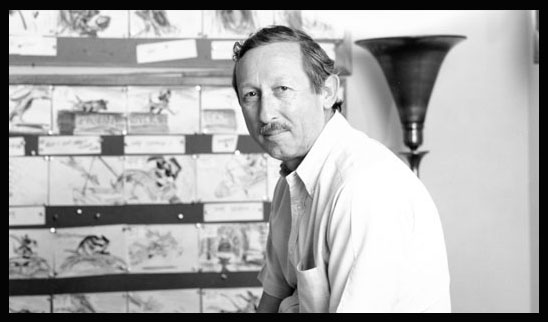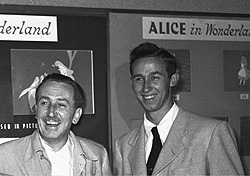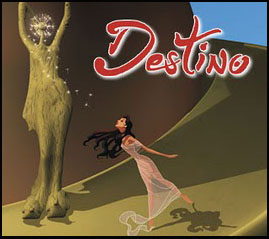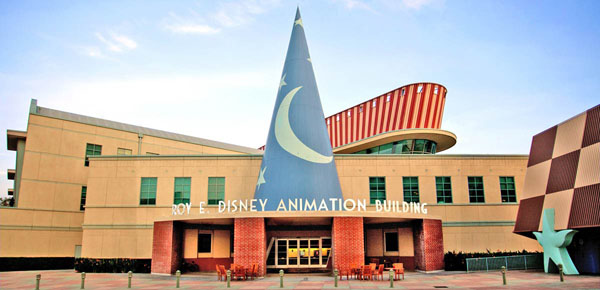
Roy Edward was born on January 10, 1930. He was the only child of Walt’s older brother Roy OIiver and his wife Edna. As a school kid, Roy was teased mercilessly by his fellow classmates who wondered aloud if he had been the model for Goofy.
 Roy passed away of stomach cancer (he was a heavy smoker all his life) on December 16, 2009 at the age of 79 and was cremated. Unfortunately, many of the worthy projects that he had quietly supported behind-the-scenes and were in the works were then quietly abandoned.
Roy passed away of stomach cancer (he was a heavy smoker all his life) on December 16, 2009 at the age of 79 and was cremated. Unfortunately, many of the worthy projects that he had quietly supported behind-the-scenes and were in the works were then quietly abandoned.
When Michael Eisner became CEO in 1984, he considered dismantling the animation department since it was costly and time consuming, and there were enough classics in the vaults to re-release. Supposedly, one of the reasons Eisner gave the position of overseeing Disney feature animation to Roy was that if the animation department collapsed as he expected, Eisner could always point that the failure came under the hands of a Disney.
Former Disney animation chief Peter Schneider stated in 2000 to a reporter that “the single-most important thing in the history of animation at the company was Roy Disney’s persuasion in 1984 of then-president Wells to spend a mere $10 million on computer equipment to restore the animation quality lost through previous cuts. Not only did it restore colors and blushes, it also led to innovations in movement and forged the kind of style that distinguishes such films as Beauty and The Beast (1991).”
 Despite helping revive Disney Feature Animation, Roy’s influence became more and more muted over the years but it was still enough for him to authorize the Disney Company to assist Leslie Iwerks on the book and documentary about her grandfather Ub Iwerks; to make sure that the Salvador Dali-Disney collaboration Destino (2003) was finally completed (despite Eisner’s displeasure); and to instigate the restoration of Richard Williams’ original version of The Thief and the Cobbler and more.
Despite helping revive Disney Feature Animation, Roy’s influence became more and more muted over the years but it was still enough for him to authorize the Disney Company to assist Leslie Iwerks on the book and documentary about her grandfather Ub Iwerks; to make sure that the Salvador Dali-Disney collaboration Destino (2003) was finally completed (despite Eisner’s displeasure); and to instigate the restoration of Richard Williams’ original version of The Thief and the Cobbler and more.
Roy didn’t feel the Disney Company should have made Hunchback of Notre Dame (1996) because he felt the tone was too dark, and he didn’t care for some scenes in The Lion King (1994), like the sequence set to Elton John’s “Can You Feel The Love Tonight?” and his outspokenness found him being marginalized.
Here is a brief excerpt of an interview I did with Roy in 2004 when he was trying to gather support for his Save Disney campaign.
Jim Korkis: Do you have a favorite Disney animated film?
Roy E. Disney: My first impulse right now is to say Snow White. I was just a kid and it made a real impression on me because there was nothing else like it. I remember the premiere of the film very well. I had seen it several times before it opened but it was that opening at the Carthay Theater that somehow made it all real.
JK: Of course, there is that famous story about Walt telling you the story of Pinocchio which was the film he made after Snow White.
 RD: He could be a tough boss but he was also a very warm uncle. I was home in bed with the chicken pox. It was miserable. Have you ever had chicken pox? You get isolated until you start getting better. Walt and Lilly came over to the house to have dinner with my Dad and mom. Walt knew I was feeling bad so he came into my room and sat on the edge of the bed and told me the entire story of Pinocchio. He acted out all the different parts, including the whale and everything else.
RD: He could be a tough boss but he was also a very warm uncle. I was home in bed with the chicken pox. It was miserable. Have you ever had chicken pox? You get isolated until you start getting better. Walt and Lilly came over to the house to have dinner with my Dad and mom. Walt knew I was feeling bad so he came into my room and sat on the edge of the bed and told me the entire story of Pinocchio. He acted out all the different parts, including the whale and everything else.
He scared me to death with the stuff about the whale. He was an incredible storyteller. You really have no idea how good he was. He became the story. He became all the characters. He believed in it completely. He was hypnotic. That is how I would describe it. He was better in person than on TV or anything else.
What a great story the way he told it. I remember it very, very sharply and very clearly even today. He was that good a storyteller. But when the movie came out, it was big letdown for me. It was nowhere near as good as Walt’s version.
That was his way of working things out when it came to a story. He’d tell it and he’d watch your reaction. If he could get a laugh out of you, or a tear, or whatever, he’d know it was working. If you seemed to not be paying attention, he knew he needed to work on that part.
JK: You certainly became a great advocate of animation in the Disney Company.
 RD: I never had much to do with animation when I first worked at the studio, but I grew up around it and I certainly understood the process very well. I understood the people who were there at the time and what they were trying to do. When I was a kid hanging around at the studio, the animators would pull me in to show me things and say, “Watch this, kid, and see if you think it’s funny.”
RD: I never had much to do with animation when I first worked at the studio, but I grew up around it and I certainly understood the process very well. I understood the people who were there at the time and what they were trying to do. When I was a kid hanging around at the studio, the animators would pull me in to show me things and say, “Watch this, kid, and see if you think it’s funny.”
When the Board of Directors voted in Michael [Eisner] and Frank [Wells], all of us had this big celebration lunch. Michael looked at me and, towards the end of the lunch, said, ‘Now that all of this is all over, what do you want to do?’ And without thinking, I said, ‘Why don’t you give me animation?’ Because I felt that Disney animation had fallen away from those things that had made it so extraordinary.
At that time, (animators/directors) John Musker and Ron Clements had this little story they’d been working on that wound up becoming The Great Mouse Detective (1986). We gave them a go-ahead within a week, just so the animators had something to work on, because we were paying them all this time and they were just sitting around. It turned out to be a good little movie, but it proved not only to the outside world but to ourselves that we could still do it. Then we began to dream bigger.
JK: You resigned from the Disney Company twice. Once in 1984 and brought in Eisner and Wells to replace the existing upper management and then again in 2004 to oust Eisner.
RD: When your name is on it, you have to be passionate. The first time, in the 1970s, I just felt creatively the company was not going anywhere interesting. It was very stifling. They were ignoring my complaints that we needed to focus on the film division and produce some good films. The next time, I felt that the company was focusing on emphasizing short-term monetary gains over long term goals and that the company was more interested in making money than making something good, and not realizing that investing in making something good would result in more money.



 Jim Korkis is an internationally respected animation historian who in recent years has devoted his attention to the many worlds of Disney. He was a columnist for a variety of animation magazines. With his former writing partner, John Cawley, he authored several animation related books including The Encyclopedia of Cartoon Superstars, How to Create Animation, Cartoon Confidential and Get Animated’s Animation Art Buyer’s Guide. He taught animation classes at the Disney Institute in Florida as well as instructing classes on acting and animation history for Disney Feature Animation: Florida.
Jim Korkis is an internationally respected animation historian who in recent years has devoted his attention to the many worlds of Disney. He was a columnist for a variety of animation magazines. With his former writing partner, John Cawley, he authored several animation related books including The Encyclopedia of Cartoon Superstars, How to Create Animation, Cartoon Confidential and Get Animated’s Animation Art Buyer’s Guide. He taught animation classes at the Disney Institute in Florida as well as instructing classes on acting and animation history for Disney Feature Animation: Florida.




















































Wow, great interview with the late Roy E. Disney, Jim! Without him, then Disney Animation would’ve never gotten to more than greater heights than it had been before!